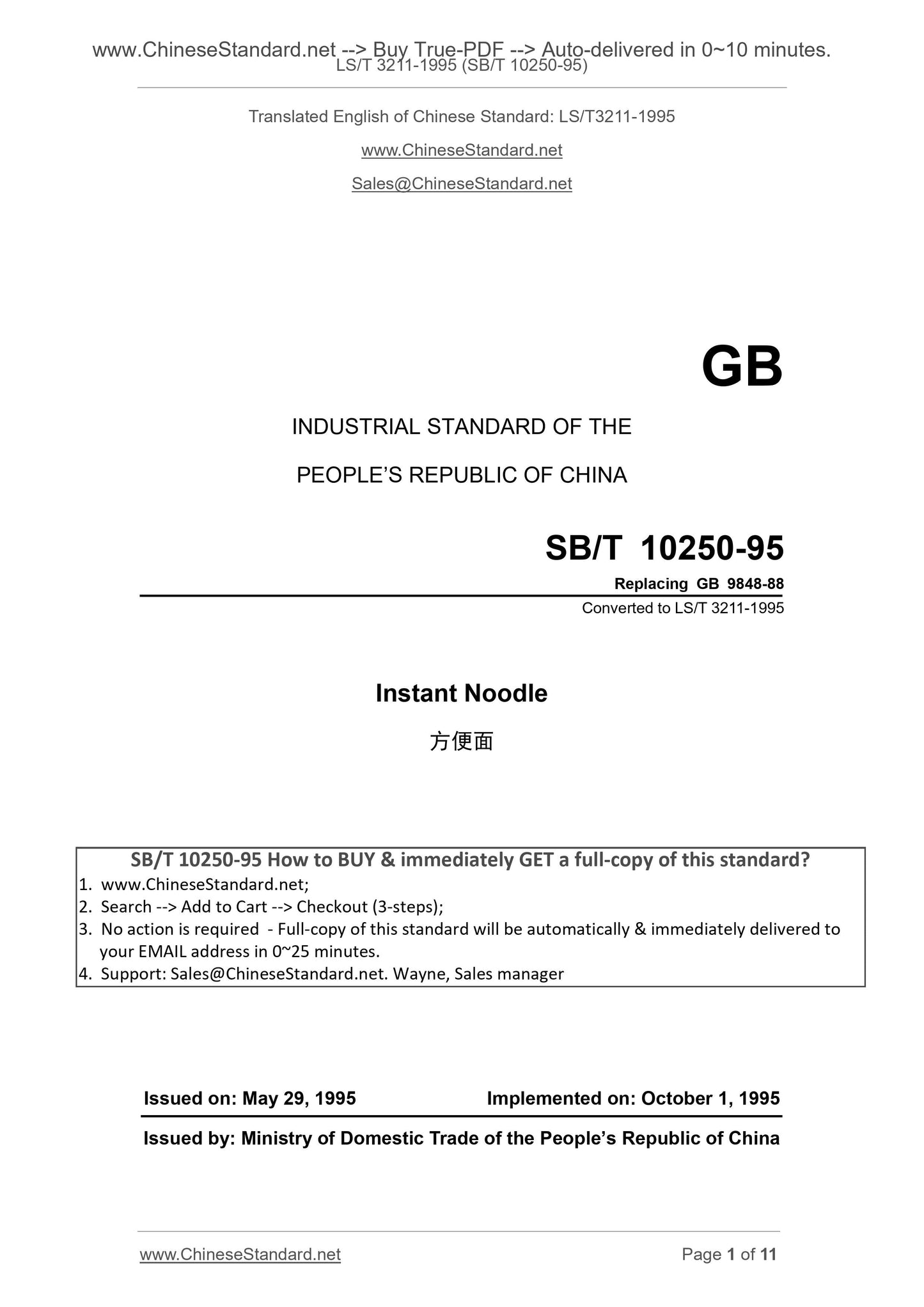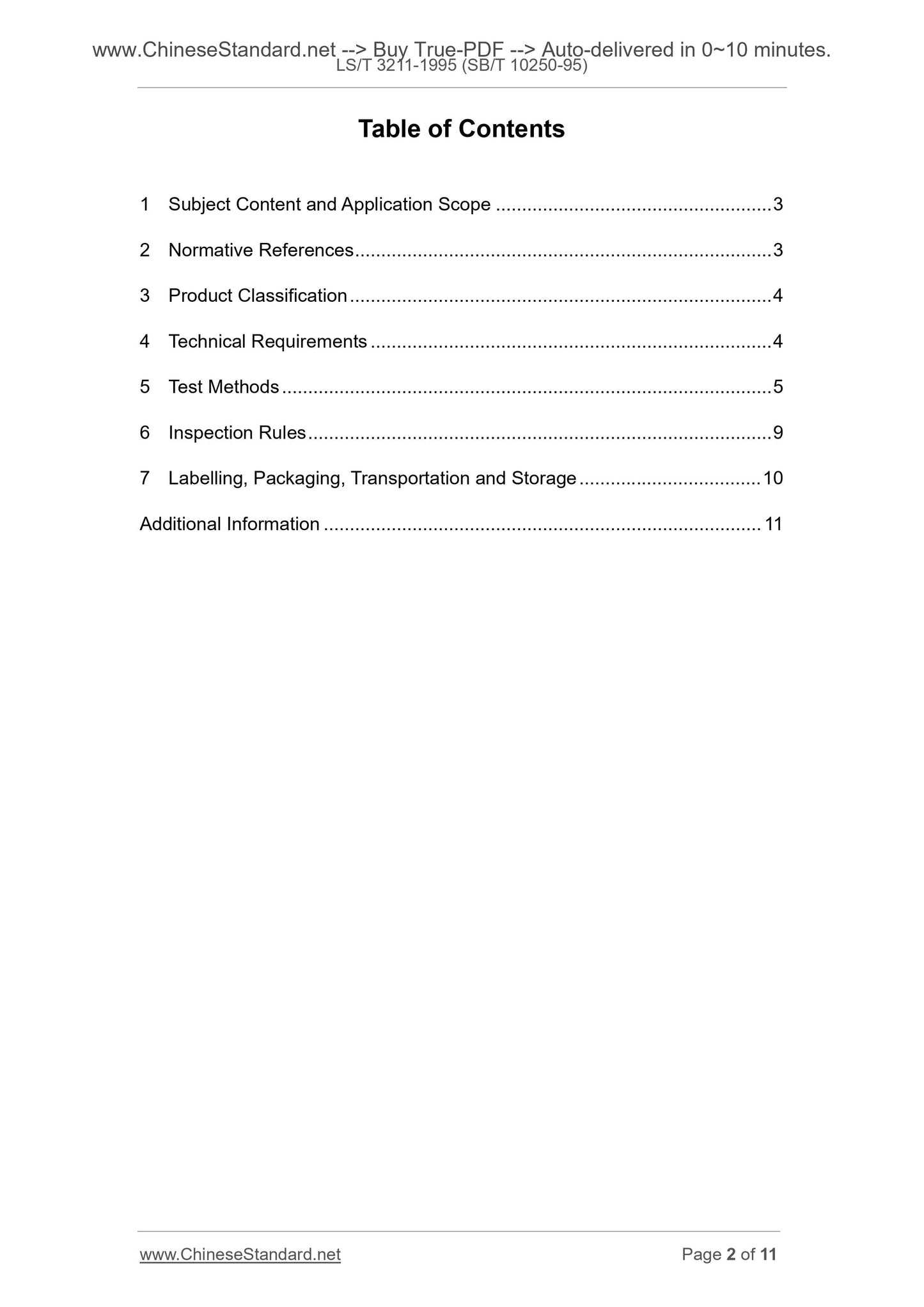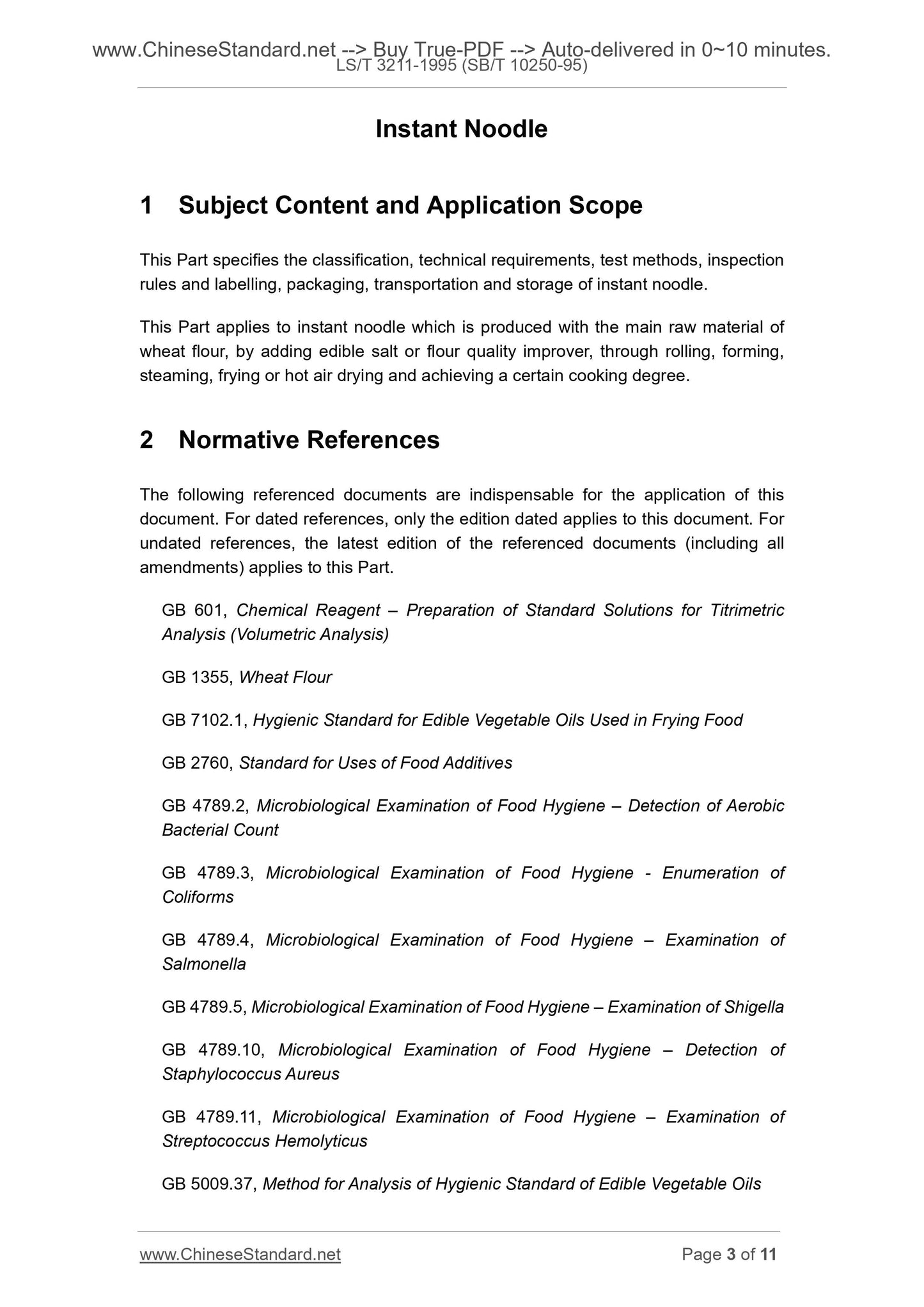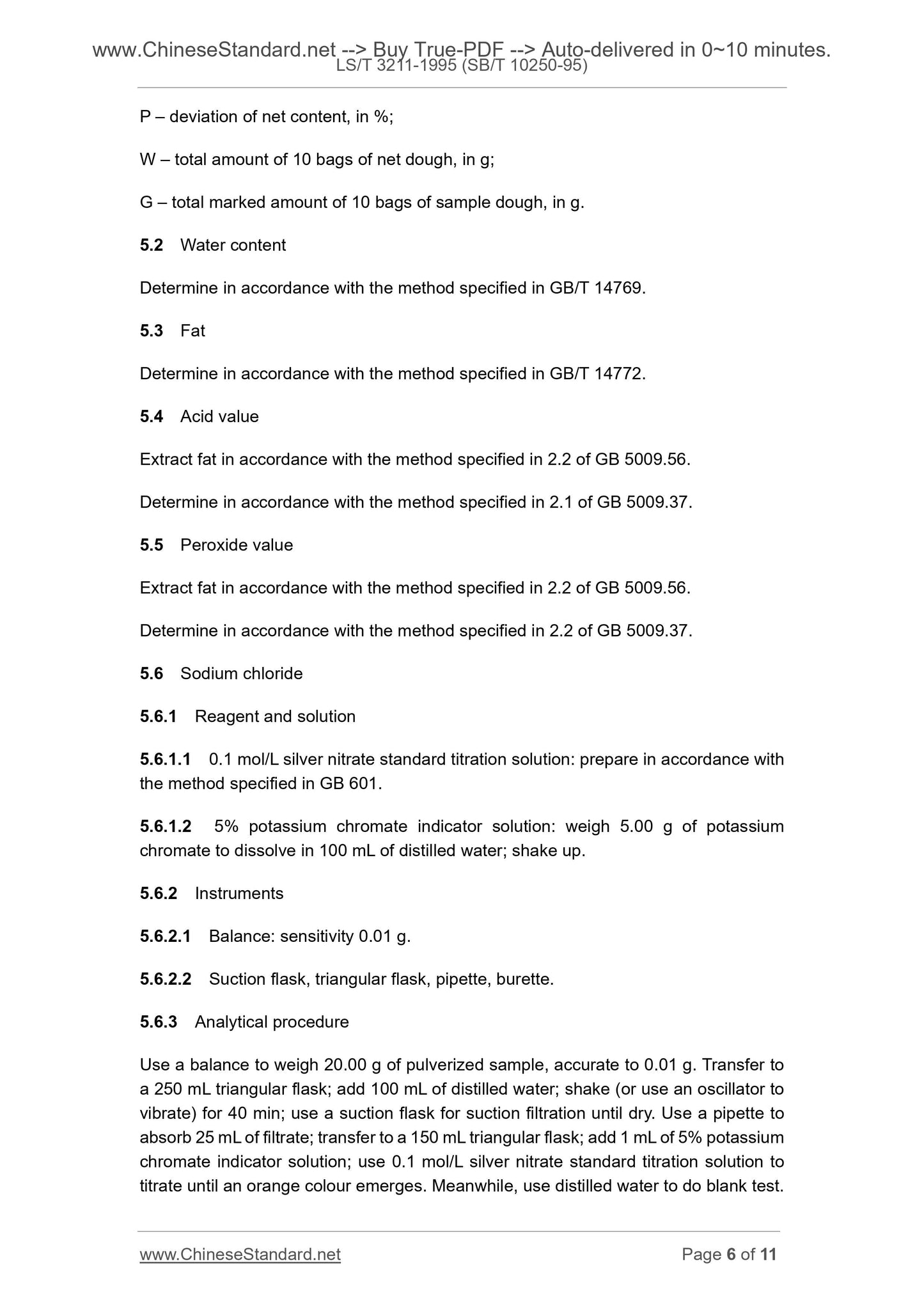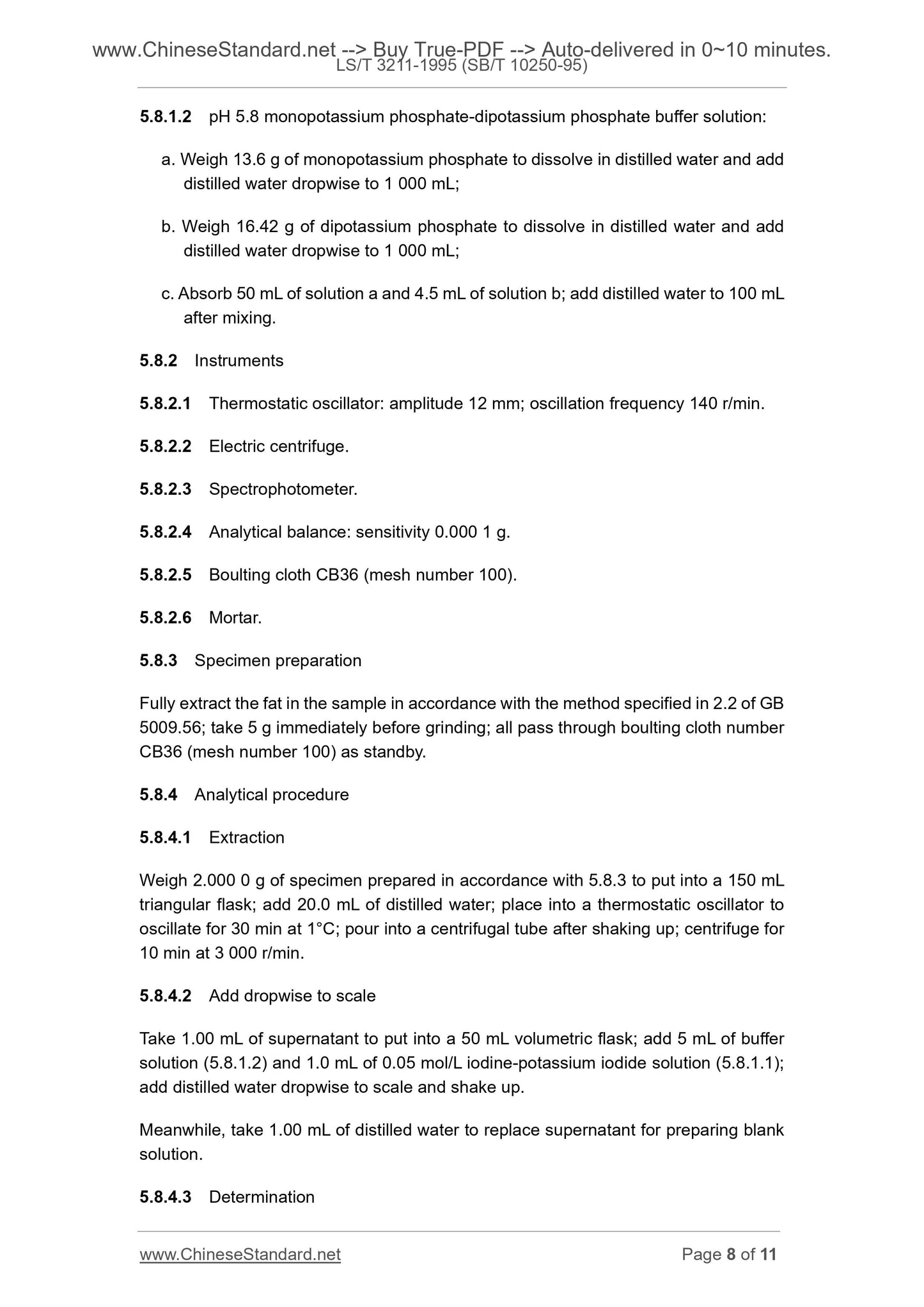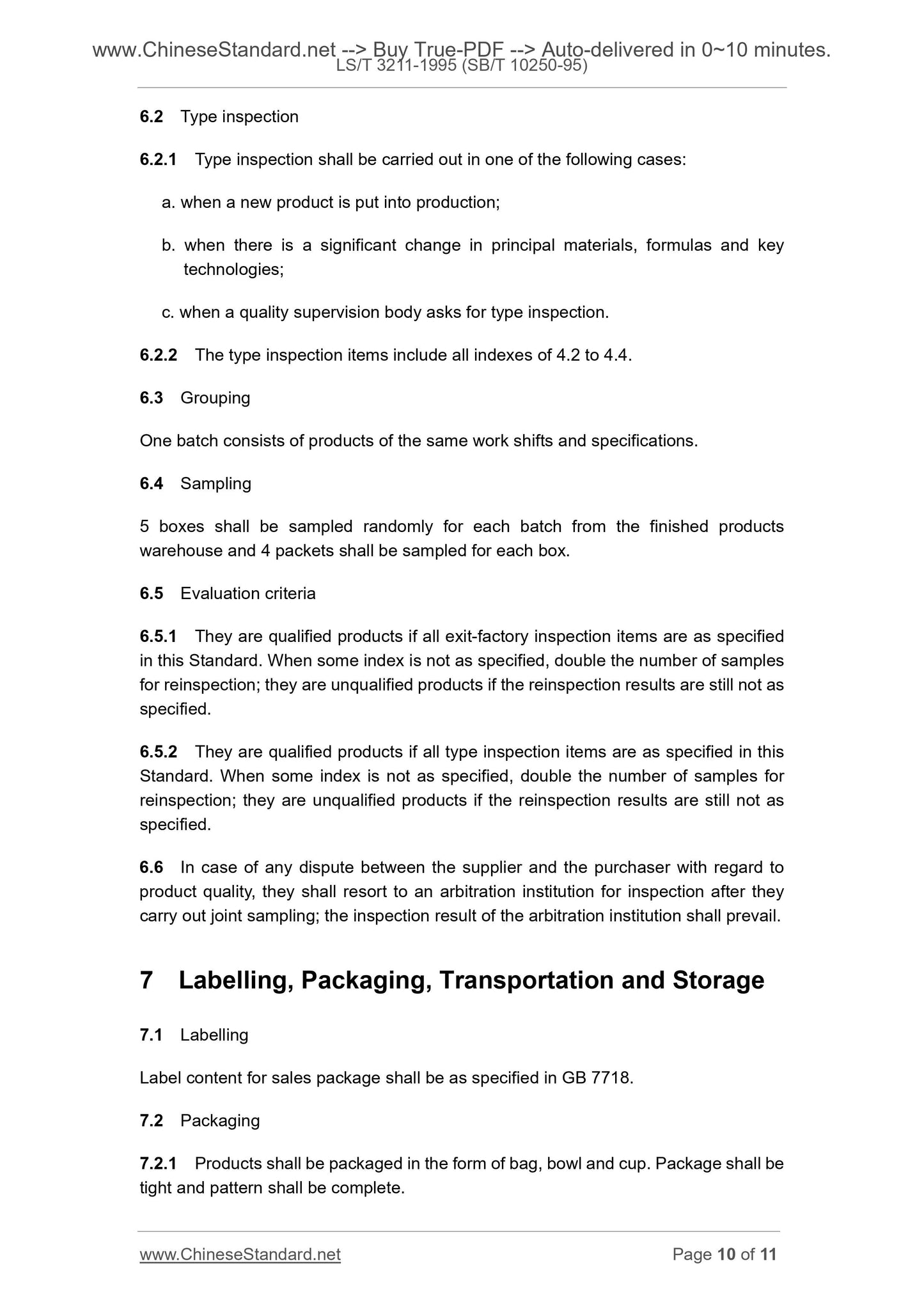1
/
of
6
PayPal, credit cards. Download editable-PDF and invoice in 1 second!
LS/T 3211-1995 English PDF (LS/T3211-1995)
LS/T 3211-1995 English PDF (LS/T3211-1995)
Regular price
$100.00 USD
Regular price
Sale price
$100.00 USD
Unit price
/
per
Shipping calculated at checkout.
Couldn't load pickup availability
Delivery: 3 seconds. Download true-PDF + Invoice.
Get QUOTATION in 1-minute: Click LS/T 3211-1995
Historical versions: LS/T 3211-1995
Preview True-PDF (Reload/Scroll if blank)
LS/T 3211-1995: Instant Noodle
LS/T 3211-1995 (SB/T 10250-95)
GB
INDUSTRIAL STANDARD OF THE
PEOPLE’S REPUBLIC OF CHINA
SB/T 10250-95
Replacing GB 9848-88
Converted to LS/T 3211-1995
Instant Noodle
ISSUED ON. MAY 29, 1995
IMPLEMENTED ON. OCTOBER 1, 1995
Issued by. Ministry of Domestic Trade of the People’s Republic of China
Table of Contents
1 Subject Content and Application Scope ... 3
2 Normative References ... 3
3 Product Classification ... 4
4 Technical Requirements ... 4
5 Test Methods ... 5
6 Inspection Rules ... 9
7 Labelling, Packaging, Transportation and Storage ... 10
Additional Information ... 11
Instant Noodle
1 Subject Content and Application Scope
This Part specifies the classification, technical requirements, test methods, inspection
rules and labelling, packaging, transportation and storage of instant noodle.
This Part applies to instant noodle which is produced with the main raw material of
wheat flour, by adding edible salt or flour quality improver, through rolling, forming,
steaming, frying or hot air drying and achieving a certain cooking degree.
2 Normative References
The following referenced documents are indispensable for the application of this
document. For dated references, only the edition dated applies to this document. For
undated references, the latest edition of the referenced documents (including all
amendments) applies to this Part.
GB 601, Chemical Reagent – Preparation of Standard Solutions for Titrimetric
Analysis (Volumetric Analysis)
GB 1355, Wheat Flour
GB 7102.1, Hygienic Standard for Edible Vegetable Oils Used in Frying Food
GB 2760, Standard for Uses of Food Additives
GB 4789.2, Microbiological Examination of Food Hygiene – Detection of Aerobic
Bacterial Count
GB 4789.3, Microbiological Examination of Food Hygiene - Enumeration of
Coliforms
GB 4789.4, Microbiological Examination of Food Hygiene – Examination of
Salmonella
GB 4789.5, Microbiological Examination of Food Hygiene – Examination of Shigella
GB 4789.10, Microbiological Examination of Food Hygiene – Detection of
Staphylococcus Aureus
GB 4789.11, Microbiological Examination of Food Hygiene – Examination of
Streptococcus Hemolyticus
GB 5009.37, Method for Analysis of Hygienic Standard of Edible Vegetable Oils
P – deviation of net content, in %;
W – total amount of 10 bags of net dough, in g;
G – total marked amount of 10 bags of sample dough, in g.
5.2 Water content
Determine in accordance with the method specified in GB/T 14769.
5.3 Fat
Determine in accordance with the method specified in GB/T 14772.
5.4 Acid value
Extract fat in accordance with the method specified in 2.2 of GB 5009.56.
Determine in accordance with the method specified in 2.1 of GB 5009.37.
5.5 Peroxide value
Extract fat in accordance with the method specified in 2.2 of GB 5009.56.
Determine in accordance with the method specified in 2.2 of GB 5009.37.
5.6 Sodium chloride
5.6.1 Reagent and solution
5.6.1.1 0.1 mol/L silver nitrate standard titration solution. prepare in accordance with
the method specified in GB 601.
5.6.1.2 5% potassium chromate indicator solution. weigh 5.00 g of potassium
chromate to dissolve in 100 mL of distilled water; shake up.
5.6.2 Instruments
5.6.2.1 Balance. sensitivity 0.01 g.
5.6.2.2 Suction flask, triangular flask, pipette, burette.
5.6.3 Analytical procedure
Use a balance to weigh 20.00 g of pulverized sample, accurate to 0.01 g. Transfer to
a 250 mL triangular flask; add 100 mL of distilled water; shake (or use an oscillator to
vibrate) for 40 min; use a suction flask for suction filtration until dry. Use a pipette to
absorb 25 mL of filtrate; transfer to a 150 mL triangular flask; add 1 mL of 5% potassium
chromate indicator solution; use 0.1 mol/L silver nitrate standard titration solution to
titrate until an orange colour emerges. Meanwhile, use distilled water to do blank test.
5.8.1.2 pH 5.8 monopotassium phosphate-dipotassium phosphate buffer solution.
a. Weigh 13.6 g of monopotassium phosphate to dissolve in distilled water and add
distilled water dropwise to 1 000 mL;
b. Weigh 16.42 g of dipotassium phosphate to dissolve in distilled water and add
distilled water dropwise to 1 000 mL;
c. Absorb 50 mL of solution a and 4.5 mL of solution b; add distilled water to 100 mL
after mixing.
5.8.2 Instruments
5.8.2.1 Thermostatic oscillator. amplitude 12 mm; oscillation frequency 140 r/min.
5.8.2.2 Electric centrifuge.
5.8.2.3 Spectrophotometer.
5.8.2.4 Analytical balance. sensitivity 0.000 1 g.
5.8.2.5 Boulting cloth CB36 (mesh number 100).
5.8.2.6 Mortar.
5.8.3 Specimen preparation
Fully extract the fat in the sample in accordance with the method specified in 2.2 of GB
5009.56; take 5 g immediately before grinding; all pass through boulting cloth number
CB36 (mesh number 100) as standby.
5.8.4 Analytical procedure
5.8.4.1 Extraction
Weigh 2.000 0 g of specimen prepared in accordance with 5.8.3 to put into a 150 mL
triangular flask; add 20.0 mL of distilled water; place into a thermostatic oscillator to
oscillate for 30 min at 1°C; pour into a centrifugal tube after shaking up; centrifuge for
10 min at 3 000 r/min.
5.8.4.2 Add dropwise to scale
Take 1.00 mL of supernatant to put into a 50 mL volumetric flask; add 5 mL of buffer
solution (5.8.1.2) and 1.0 mL of 0.05 mol/L iodine-potassium iodide solution (5.8.1.1);
add distilled water dropwise to scale and shake up.
Meanwhile, take 1.00 mL of distilled water to replace supernatant for preparing blank
solution.
5.8.4.3 Determination
6.2 Type inspection
6.2.1 Type inspection shall be carried out in one of the following cases.
a. when a new product is put into production;
b. when there is a significant change in principal materials, formulas and key
technologies;
c. when a quality supervision body asks for type inspection.
6.2.2 The type inspection items include all indexes of 4.2 to 4.4.
6.3 Grouping
One batch consists of products of the same work shifts and specifications.
6.4 Sampling
5 boxes shall be sampled randomly for each batch from the finished products
warehouse and 4 packets shall be sampled for each box.
6.5 Evaluation criteria
6.5.1 They are qualified products if all exit-factory inspection items are as specified
in this Standard. When some index is not as specified, double the number of samples
for reinspection; they are unqualified products if the reinspection results are still not as
specified.
6.5.2 They are qualified products if all type inspection items are as specified in this
Standard. When some index is not as specified, double the number of samples for
reinspection; they are unqualified products if the reinspection results are still not as
specified.
6.6 In case of any dispute between the supplier and the purchaser with regard to
product quality, they shall resort to an arbitration institution for inspection after they
carry out joint sampling; the inspection result of the arbitration institution shall prevail.
7 Labelling, Packaging, Transportation and Storage
7.1 Labelling
Label content for sales package shall be as specified in GB 7718.
7.2 Packaging
7.2.1 Products shall be packaged in the form of bag, bowl and cup. Package shall be
tight and pattern shall be complete.
Get QUOTATION in 1-minute: Click LS/T 3211-1995
Historical versions: LS/T 3211-1995
Preview True-PDF (Reload/Scroll if blank)
LS/T 3211-1995: Instant Noodle
LS/T 3211-1995 (SB/T 10250-95)
GB
INDUSTRIAL STANDARD OF THE
PEOPLE’S REPUBLIC OF CHINA
SB/T 10250-95
Replacing GB 9848-88
Converted to LS/T 3211-1995
Instant Noodle
ISSUED ON. MAY 29, 1995
IMPLEMENTED ON. OCTOBER 1, 1995
Issued by. Ministry of Domestic Trade of the People’s Republic of China
Table of Contents
1 Subject Content and Application Scope ... 3
2 Normative References ... 3
3 Product Classification ... 4
4 Technical Requirements ... 4
5 Test Methods ... 5
6 Inspection Rules ... 9
7 Labelling, Packaging, Transportation and Storage ... 10
Additional Information ... 11
Instant Noodle
1 Subject Content and Application Scope
This Part specifies the classification, technical requirements, test methods, inspection
rules and labelling, packaging, transportation and storage of instant noodle.
This Part applies to instant noodle which is produced with the main raw material of
wheat flour, by adding edible salt or flour quality improver, through rolling, forming,
steaming, frying or hot air drying and achieving a certain cooking degree.
2 Normative References
The following referenced documents are indispensable for the application of this
document. For dated references, only the edition dated applies to this document. For
undated references, the latest edition of the referenced documents (including all
amendments) applies to this Part.
GB 601, Chemical Reagent – Preparation of Standard Solutions for Titrimetric
Analysis (Volumetric Analysis)
GB 1355, Wheat Flour
GB 7102.1, Hygienic Standard for Edible Vegetable Oils Used in Frying Food
GB 2760, Standard for Uses of Food Additives
GB 4789.2, Microbiological Examination of Food Hygiene – Detection of Aerobic
Bacterial Count
GB 4789.3, Microbiological Examination of Food Hygiene - Enumeration of
Coliforms
GB 4789.4, Microbiological Examination of Food Hygiene – Examination of
Salmonella
GB 4789.5, Microbiological Examination of Food Hygiene – Examination of Shigella
GB 4789.10, Microbiological Examination of Food Hygiene – Detection of
Staphylococcus Aureus
GB 4789.11, Microbiological Examination of Food Hygiene – Examination of
Streptococcus Hemolyticus
GB 5009.37, Method for Analysis of Hygienic Standard of Edible Vegetable Oils
P – deviation of net content, in %;
W – total amount of 10 bags of net dough, in g;
G – total marked amount of 10 bags of sample dough, in g.
5.2 Water content
Determine in accordance with the method specified in GB/T 14769.
5.3 Fat
Determine in accordance with the method specified in GB/T 14772.
5.4 Acid value
Extract fat in accordance with the method specified in 2.2 of GB 5009.56.
Determine in accordance with the method specified in 2.1 of GB 5009.37.
5.5 Peroxide value
Extract fat in accordance with the method specified in 2.2 of GB 5009.56.
Determine in accordance with the method specified in 2.2 of GB 5009.37.
5.6 Sodium chloride
5.6.1 Reagent and solution
5.6.1.1 0.1 mol/L silver nitrate standard titration solution. prepare in accordance with
the method specified in GB 601.
5.6.1.2 5% potassium chromate indicator solution. weigh 5.00 g of potassium
chromate to dissolve in 100 mL of distilled water; shake up.
5.6.2 Instruments
5.6.2.1 Balance. sensitivity 0.01 g.
5.6.2.2 Suction flask, triangular flask, pipette, burette.
5.6.3 Analytical procedure
Use a balance to weigh 20.00 g of pulverized sample, accurate to 0.01 g. Transfer to
a 250 mL triangular flask; add 100 mL of distilled water; shake (or use an oscillator to
vibrate) for 40 min; use a suction flask for suction filtration until dry. Use a pipette to
absorb 25 mL of filtrate; transfer to a 150 mL triangular flask; add 1 mL of 5% potassium
chromate indicator solution; use 0.1 mol/L silver nitrate standard titration solution to
titrate until an orange colour emerges. Meanwhile, use distilled water to do blank test.
5.8.1.2 pH 5.8 monopotassium phosphate-dipotassium phosphate buffer solution.
a. Weigh 13.6 g of monopotassium phosphate to dissolve in distilled water and add
distilled water dropwise to 1 000 mL;
b. Weigh 16.42 g of dipotassium phosphate to dissolve in distilled water and add
distilled water dropwise to 1 000 mL;
c. Absorb 50 mL of solution a and 4.5 mL of solution b; add distilled water to 100 mL
after mixing.
5.8.2 Instruments
5.8.2.1 Thermostatic oscillator. amplitude 12 mm; oscillation frequency 140 r/min.
5.8.2.2 Electric centrifuge.
5.8.2.3 Spectrophotometer.
5.8.2.4 Analytical balance. sensitivity 0.000 1 g.
5.8.2.5 Boulting cloth CB36 (mesh number 100).
5.8.2.6 Mortar.
5.8.3 Specimen preparation
Fully extract the fat in the sample in accordance with the method specified in 2.2 of GB
5009.56; take 5 g immediately before grinding; all pass through boulting cloth number
CB36 (mesh number 100) as standby.
5.8.4 Analytical procedure
5.8.4.1 Extraction
Weigh 2.000 0 g of specimen prepared in accordance with 5.8.3 to put into a 150 mL
triangular flask; add 20.0 mL of distilled water; place into a thermostatic oscillator to
oscillate for 30 min at 1°C; pour into a centrifugal tube after shaking up; centrifuge for
10 min at 3 000 r/min.
5.8.4.2 Add dropwise to scale
Take 1.00 mL of supernatant to put into a 50 mL volumetric flask; add 5 mL of buffer
solution (5.8.1.2) and 1.0 mL of 0.05 mol/L iodine-potassium iodide solution (5.8.1.1);
add distilled water dropwise to scale and shake up.
Meanwhile, take 1.00 mL of distilled water to replace supernatant for preparing blank
solution.
5.8.4.3 Determination
6.2 Type inspection
6.2.1 Type inspection shall be carried out in one of the following cases.
a. when a new product is put into production;
b. when there is a significant change in principal materials, formulas and key
technologies;
c. when a quality supervision body asks for type inspection.
6.2.2 The type inspection items include all indexes of 4.2 to 4.4.
6.3 Grouping
One batch consists of products of the same work shifts and specifications.
6.4 Sampling
5 boxes shall be sampled randomly for each batch from the finished products
warehouse and 4 packets shall be sampled for each box.
6.5 Evaluation criteria
6.5.1 They are qualified products if all exit-factory inspection items are as specified
in this Standard. When some index is not as specified, double the number of samples
for reinspection; they are unqualified products if the reinspection results are still not as
specified.
6.5.2 They are qualified products if all type inspection items are as specified in this
Standard. When some index is not as specified, double the number of samples for
reinspection; they are unqualified products if the reinspection results are still not as
specified.
6.6 In case of any dispute between the supplier and the purchaser with regard to
product quality, they shall resort to an arbitration institution for inspection after they
carry out joint sampling; the inspection result of the arbitration institution shall prevail.
7 Labelling, Packaging, Transportation and Storage
7.1 Labelling
Label content for sales package shall be as specified in GB 7718.
7.2 Packaging
7.2.1 Products shall be packaged in the form of bag, bowl and cup. Package shall be
tight and pattern shall be complete.
Share
